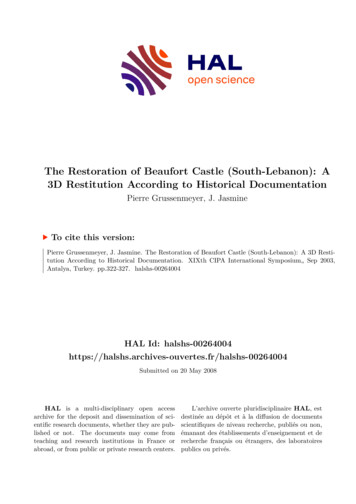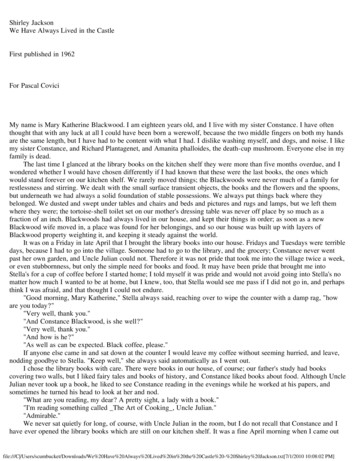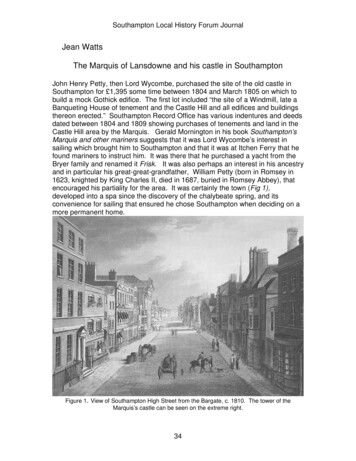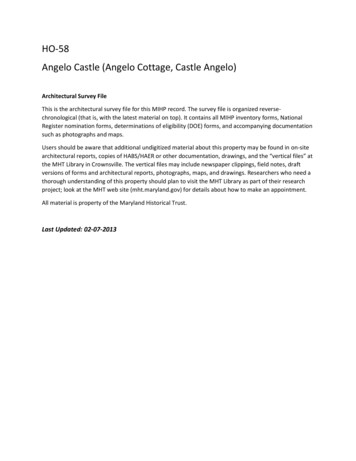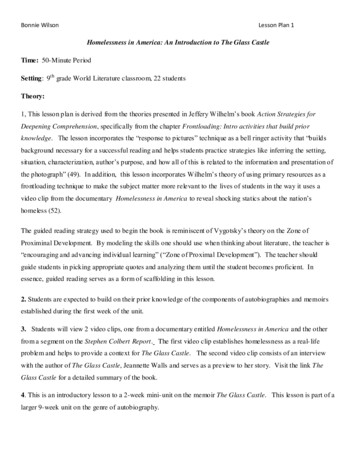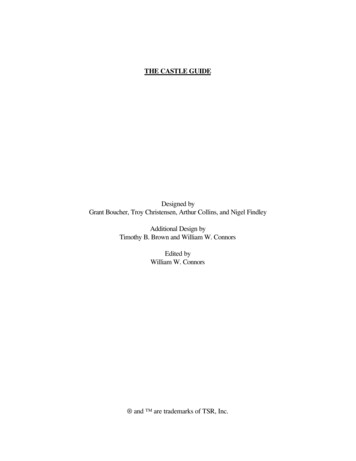
Transcription
THE CASTLE GUIDEDesigned byGrant Boucher, Troy Christensen, Arthur Collins, and Nigel FindleyAdditional Design byTimothy B. Brown and William W. ConnorsEdited byWilliam W. Connors and are trademarks of TSR, Inc.
1990 TSR, Inc. All Rights Reserved
Table of ContentsIntroductionWhat’s in This Book?Using The Castle GuideChapter 1: The Feudal SettingMerging Fact and FantasyNotes on Campaign PoliticsFeudal SocietySocial ClassesMembers of the CourtA Note about MagicThe Role of the ChurchPolitics and ChurchesCrimes and PunishmentsDeath by TaxesPopulating the CastlePaying for Your Castle or KingdomBribery Is Your FriendA Day in the Life of a PeasantChapter 2: In the Days of KnightsKnights of GloryNothing Is FreeWar HorsesIn Search of High AdventureKnighthood for Non-WarriorsThe Road to KnighthoodThe Chivalric CodeMaid to FitFalling from GraceRogue KnightsHeraldryDemi-Human KnightsChapter 3: The TournamentHigh HolidaysPrivate CelebrationsTestsChallengesLocal FairsNoble TournamentsJoustingArcheryHoly DebatesWizardry CompetitionsChapter 4: The Evolution of CastlesThe Castle’s Role
Types of CastlesChapter 5: Castle ConstructionAcquiring LandThe Construction SiteClimate TypeGeographyGround CoverResource AvailabilityThe Work ForceLocal Social StructureWorker SkillWorker MoraleCastle Modules TableCastle DesignCastle ModulesAverage Construction Time & CostWorks of ArtOverhead CostsFinal CalculationsThe Work ForceWork SeasonsMonthly EventsChapter 6: Unusual CastlesOriental DesignsThieves’ CastlesWizards’ KeepsPriests’ FortressesPaladins’ CastlesRangers’ FortsDruids’ ShrinesDwarven CitadelsElven SanctuariesHalfling StrongholdsGnomish CastlesOrcish KeepsChapter 7: Warfare!Offensive TacticsInvestmentMedieval TacticsStarvationThirstLater PeriodsFantastic CombatReductionEscalade
Airborne OperationsBreaching the WallsSiege Attack ValuesThe Course of a SiegeExcavationMiningTrickery and CorruptionMorale IssuesDefensive TacticsFortificationsSortiesDefending the WallsMorale IssuesSurrenderSiege EnginesChapter 8: Quick Resolution SystemsSiege ResolutionFighting CampaignsWar in the Medieval AgeWar PlansBattle ResolutionCampaign Victory--Winning the WarCharacter InvolvementChapter 9: Generic CastlesCyclops TowerBremberthwaite ManorKinniver Castle
INTRODUCTIONPrepare yourself for a voyage back in time.As you read this book, you will be drawn back through the years to an age when castlesdominated the landscape of Europe. Here, amid these mighty stone halls, you will find knights inshining armor and great battles fought by men and women with steel swords and iron nerves.Welcome to the Age of Chivalry.What’s in this book?The Castle Guide is an outgrowth of the AD&D 2nd edition game rules. In theDUNGEON MASTER Guide and Player’s Handbook a general rules system wasestablished that allows the Dungeon Master to run a variety of fantasy role-playing styles. In thisbook, however, we will focus in on a specific style of game, one set in a society similar to that offeudal Europe, and give you the background information you need to make it come to life.The first section of this book begins with an overview of medieval society and the feudalsystem in general. Here, you will come to understand the forces that drive a feudal governmentand the relationship between the state and its churches.Following this, we go on to detail the ways in which player characters can become knights,the stout defenders of the realm. The code of chivalry is examined and the standards by which aknight must live his or her life are addressed. In closing the first section, we offer a guide tomedieval tournaments. Here, characters get the chance to show off their skills and try for thehand of the beautiful princess (or handsome prince).Our second section examines the evolution of castles in medieval Europe and provides anoverview of their advantages and disadvantages. Following that, we present a modular systemfor the design and construction of castles for use by player characters and NPCs alike. With thissimple system, the DM can determine just how much it will cost a character to build the keep ofhis dreams and how long the construction will take. Included with this are rules for the use ofmagical items and monsters in the building process.For those of you who are fond of the BATTLESYSTEM miniatures rules, we haveincluded the third portion of The Castle Guide. Here, we expand upon the BATTLESYSTEMrules and provide rules for resolving long sieges and the defense of castles. Material in thissection addresses the elements of a fantasy world that make defending a castle more than justan exercise in historical simulation. In addition, we look at the various types of castles found inthe AD&D game, including those of the dwarves and elves.If you aren’t interested in fighting out individual battles with miniatures, we have taken care toinclude a pair of quick resolution systems. The first of these can be used to resolve individualsieges, while the second can be employed to determine the victor in an individual battle or allout military campaign.Lastly, we have included a trio of generic castles for use by the Dungeon Master in setting uphis game. If time is tight, any one of these structures can be easily adapted to serve as an NPC’sbase of operations or as a model of medieval design techniques.Using The Castle GuideAs you can see, there is a great deal of information in this book. Of course, you can use asmuch or as little of it as you want in your AD&D game. If you are using the CompleteFighter’s Handbook in your campaign, you will find that much of the information in this book
works well with the cavalier and swashbuckler kits especially. However, anyone who runs acampaign that has elements of feudal Europe in it will find something of value to them in thisbook.For those who want to set their campaign against the backdrop of a great war, as was done inTolkien’s Lord of the Rings trilogy, the quick resolution systems presented in chapter 8 willallow players to focus on the role-playing aspects of the game, while still being able to changethe course of a battle or turn the tide of an entire war.If you enjoy war games and want to mesh your AD&D game campaign more fully with yourBATTLESYSTEM games, the sections on warfare will also provide you with lots of informationfor new scenarios. With the addition of the material in this book, role-playing’s premierminiatures rules system reaches new heights. Knights, mount your horses. The time for battle isat hand!
CHAPTER 1: THE FEUDAL SETTINGMerging Fact and FantasyMany of us got into role-playing games when we met some friends who simply asked us to“come by and watch.” Little did we know that we had already watched plenty of role-playinggames in our all too short lives. In fact, the films and novels we’ve read over the years hold thatsame spark of imagination that drew us into these crazy games in the first place.When setting up a new campaign world, there are two basic schools of thought: those whofeel the game should be very historically accurate and those who do not. Of course, theintroduction of magic into the historic world is a mainstay of the AD&D game and cannot helpbut distort an otherwise historic setting.So, which do you choose in your campaign? Is your world going to be classically accurate, asit was seen in the great Roman and Biblical epics we’ve all watched on TV? Or will the worldhave an element of magic and superstition lurking just out of sight (or even in full view), like thegreat epic stories of Excalibur and Conan the Barbarian?If you choose the latter, you must decide how far to take the magic. Very popular in recentfantasy literature are the “no holds barred” magical worlds where everyone and their brotherlives and breathes magic. In many ways, this is similar to the way in which the average personsees technology today. After all, most people have no idea how a television set works, but theyaccept it as a common part of their daily lives.The average AD&D campaign remains somewhat in the middle, along the lines of Tolkien’sworks and the stories of King Arthur. In this book, we will assume that this is the norm. Ofcourse, because the AD&D game is your game, no single style of play is considered to becorrect. If you and your players are having fun, then you’re playing the game properly.As with all things in the AD&D game, your interpretation is what matters, so feel free to pickand choose, discard and exploit. The more excited you get about your choices, the more yourcampaign will thrive and grow. Hopefully, this information will give you a wealth of adventureideas and add life to all your future gaming.Enjoy.Notes on Campaign PoliticsIn many campaigns, the problems of national politics fall into the background for lower levelcharacters. After all, the majority of first level adventurers are not able to cope with problemslike major wars, thwarting the ultimate evil, or slaying that most horrible of horrors, the dragon.At this point in their careers, the characters are not going to be overly concerned with theramifications of the king’s political alliances for the same reason that most of us are not expertsin the details of our country’s own foreign relations: it simply doesn’t enter into our daily lives.As they progress in levels, however, things will begin to change. At first, this will be only apassing thing. Perhaps one adventure brings their actions to the attention of a local baron who,for better or worse, makes a mental note to keep an eye on the characters. By the time theyhave reached ninth level, the characters are usually fairly well known and have acquired thestatus of folk heroes. As he begins to attract followers, the character cannot help but come tothe attention of the local government.It is almost certain that, given time, they will become as well known in their homelands (or theregion in which they adventure) as George Washington, Abraham Lincoln, or the Wright
brothers are in the modern United States. Of course, this may also mean that they are expectedto undertake tasks which seem impossible and confront unstoppable armies as a matter ofroutine duty to their king. Oh well, that’s what they get for giving up the simple life of ablacksmith.In any case, it is important to note that relationships with the local nobility (even for those whoare a part of it) are not always cordial. Just as the king can be a very valuable friend, so too canhe be a deadly adversary.Feudal SocietyThe basic element of feudalism is simple enough to understand. All in all, it is nothing morethan an agreement between two men, a lord and a vassal, to work together for their mutualbetterment.The lord, who is the recognized owner of a piece of land-gives it to the vassal, who willmanage and live on it. In exchange for such a favor, the lord is entitled to certain duties andfavors from the vassal, which include the payment of taxes and the requirement that he supportthe military forces maintained by the lord.In most cases, the owner of the land is the king and the vassals are his nobility. Of course, onecan’t expect the nobility to work the land themselves, so we come to the serfs and commonfolk.The vassal, in an agreement similar to that he which he has with his king, turns the land over tothe peasants and serfs to farm and live on. Like the vassal, they agree to work the land andprovide their lord with income and food from it. Of course, the serfs expect to earn enoughmoney to live on and to be protected by the lord in times of unrest or military conflict. The lordknows this, just as he knows that he can expect the same from the king, and is only too happyto provide it. While this doesn’t mean that life for the serfs is wonderful, it does allow them tolive without fear of extreme repression or exploitation.The feudal system works well so long as everyone in it recognizes their own responsibilitiesand the rights of others. Since they are in a position where it is in their own best interest to doso, they almost always do. Those who ignore their duties or seek to take advantage of their ownposition are quickly pegged as trouble-makers and may well be strongly disciplined by theleadership of the society.The reasons for this are simple enough to understand. While the King may not care too muchabout the life of a single serf, he must concern himself with their overall happiness. Without theserfs, his vassals have no power or income. Without the power and income of the vassals, hehimself is impotent. Each block in the pyramid of power rests very solidly on those below it inthe feudal system. Without the support of the base, the entire structure will collapse.Of course, the key to the whole thing is land. Whoever owns the land has the power. Whilethere are certain regions which might not belong to the king (a yeoman’s farm, for example)these are insignificant when compared to the vast stretches of land owned by the king himself.Even such small patches of independent land will be forced to recognize the power of the king,of course, if they are to expect any protection or assistance from the crown during times of waror calamity.Social ClassesOne important aspect of the feudal system is its clear and almost absolute recognition of social
classes. Anyone born as a serf can expect to die as a serf. There is no provision in such asociety for the advancement of individuals from a lower class into the higher classes. This is notto say that it is impossible, only that it is very difficult.How might someone in a lower class make the jump to a higher place in society? Usually bydoing a great service to one’s lord or church. In some societies, in fact, any knight has the rightto bestow the rank and title of knighthood on any individual who proves himself worth on thefield of combat. Of course, the problem with such an approach is that it often ends up in thewould-be knight’s death at the hands of a better trained and better equipped warrior. As wesaid, it is not easy to improve your place in such a system.In the following section, we will examine the many levels of society which characters in anAD&D game will encounter.SerfsBy the time of the Middle Ages, slavery had gradually fallen out of favor in feudalEurope. While there are certain to be isolated pockets of slave trading in most worlds,the vast majority of a chivalric campaign world should not be a party to it. While thedistinction between a serf and a slave may be obscure to many, the most important thingto understand is this: the serf had certain rights.While he did not own the land which he worked and did not have a say in the localgovernment, he was acknowledged to own himself. Unlike more primitive societies,where members of the lower class were thought of as animals or property, the poor in afeudal society are recognized as having a right to fair and just treatment by the nobilityand society in general.Most feudal estates have laws to protect the local serf population from abuse ormistreatment-even by members of the nobility. While these laws may be more or lessenforced, depending on the disposition of the local lord, the fact that they exist at all is amajor turning point in cultural evolution.YeomenUnlike the serf, who spent his days laboring on land owned by his lord, a yeoman wasrecognized as the owner of his own farm. As a rule, it was not a large estate, but it wasenough to provide for his needs (and those of his family). If times were good, it mighteven provide a surplus which could be sold or bartered for a few choice items orluxuries.In many cases, of course, a yeoman will swear loyalty to a near-by lord and pay himor her some tribute each year. This serves two purposes. Primarily, it allows the yeomanto keep on good terms with the lord and provides assurance that his land will not betaken from him. Secondly, it obligates the lord to help protect the yeoman’s land in theevent of a disaster or attack. In short, the gesture simply assures that the two will be“good neighbors.”TradesmenTradesmen make up the lower classes of a feudal town. They include the commonlaborers, lesser craftsmen, and small businessmen. As individuals, they hold little power.Because of their overall importance in society, however, they are treated fairly well by
the lord of the manor.As a rule, tradesmen make enough money to support themselves fairly well and toprovide a comfortable home for their families. In a modern sense, they might bedescribed as the middle class.GuildsmenIn order to counter the power which a lord maintains over his holdings and makecertain that he does not abuse his status, the members of many professions form guilds.In essence, they function like the thieves’ guild which is so much a part of many AD&Dgame campaigns. Guildsmen, the leaders of such groups, have much power in a town,for they can call on workers to stop key activities or delay important projects. Likewise,they can urge increased quality or quantity in times of strife.In addition to the important members of the various guilds, this class of citizensincludes unusually gifted artisans or those who work with precious materials (like a gemmerchant). This class may be the most diverse of any because it serves as a bufferbetween the nobility and the common folk. In modern terms, the guildsmen might beconsidered to be the upper middle class.As a side note, some guildsmen might have more actual power in a region than thenobles they serve. Such power is probably not openly manifested, but used in subtleways to help the friends and family of the guildsman. The most important members ofthis class might be considered nobles who just haven’t been given a title yet.ChivalricsThe lowest rank of the nobility, the chivalric class is made up of knights and baronswho have been given a grant of land to administer. In some cases, they have earned theland themselves through wealth, power, or service. In others, the land may have beenawarded to one of their ancestors and they have inherited the title and responsibilitieswhich come with such an estate.Members of this class are endowed by their own lord (usually a duke, count, or earl)with land of their own and a manor house or keep in which to dwell. In return, ofcourse, they swear loyalty to their benefactor and vow to serve his interests in their dailylives. As such, they pay a portion of their own incomes to him as a measure of theirrespect and gratitude. In a time of crisis, they are expected to come promptly to the aidof their superiors.NobilityThe nobility are second in status only to the royal family. In practice, they are perhapsthe most powerful of the classes. Members of the nobility, most of whom bear the titleof Count, Duke, Earl, or Marquis, are each entrusted with a large section of the king’sland. They swear loyalty to the crown, just as the members of the chivalric class swearloyalty to them. It is their responsibility to see to it that affairs in their lands are orderlyand that all taxes and revenues due to the king are collected in a timely manner.Members of the nobility have a very close relationship with the royal family, but theycan claim no direct blood ties to the throne. In the event that a great disaster were todecimate the ruling house, the successor to the throne would certainly come from this
class. The means by which such an individual came to power might be verycontroversial and a political power struggle is sure to erupt whenever the throne is leftunclaimed.Royal FamilyAt the top of it all is the royal family. Members of this group can trace a direct familyrelationship to the ruling monarch. When the current king dies, one of them will be nexton the throne. In any feudal culture, members of this class are the absolute upper crust.Everyone, even the most powerful members of the nobility, swears fealty to the royalfamily and to the king in particular.In the event of a dispute between the king and a member of the nobility, either in theform of a political challenge or an outright rebellion, members of lower classes areexpected to side with the king and royal family. For example, if a powerful countdecides to make a grab for the throne, many of the knights and barons who serve himmay well be forced to turn against him. Failure to support the king in an internal strugglecan be disastrous if the king should prove to be triumphant in the dispute.As a rule, the king will be replaced by his first born male child when he dies or stepsdown. If there is no such heir, then a pre-established pecking order exists to decidewho has claim to throne. In the event that no clear successor exists, the nobility will stepin to select which member of the royal family will become the new king. In such cases, agreat deal of political manipulation and deal making can be counted upon.The Imperial FamilyIn some cases, there exists an element of society above the traditional royal family: theimperial family. Where a king is the recognized ruler of an individual country, anemperor has united several nations under his own banner.Empires are very rare indeed. The power required to hold one together is almostimpossible for one man to attain. In most cases, an empire is formed by conquest.When one nation becomes so powerful that it can overrun a number of neighboringstates, its king is elevated to the status of an emperor.There are other ways in which an empire might be formed, but these are rare in theextreme. Several nations with the same religion might be united in a holy war whichcauses them to select a single individual as their leader. If things go well and the newleader has acquired the power to hold this alliance together after the war, an empiremay be forged.There will always be men who claim to rule empires which exist only in their ownminds, of course. It is not uncommon for a king to refer to himself as emperor and hislands as an empire. For our purposes, however, these people are no more than kingswith delusions of grandeur.Members of the CourtAny good noble will surround himself with advisors. Each of these men (or women) will be anexpert in areas which the king may not be knowledgeable about. By consulting them when he isforced to make a decision in some area, the lord can render a fair and competent ruling.Because of the modular nature of feudal governments, each of these offices is likely to be
repeated at different levels of the government. For example, the local baron is certain to have hisown seneschal, as does the count he reports to and the king above them both. Some position,such as the Lord High Wizard, will not be found in most estates due to the expense ofmaintaining such an advisor.Lord High ChamberlainOf all the positions in a lord’s court, none is more trusted or important to the dailyactivity of the estate than that of the Lord High Chamberlain. In modern terms, thechamberlain is the lord’s right-hand man. He controls all access to the Lord and can acton his behalf in any instance. Orders which are issued by the Lord High Chamberlainare assumed to come directly from the lord and must be obeyed without question.A number of individuals will report to the Lord High Chamberlain. It is his job tocoordinate reports from numerous lesser officials and present his lord with theinformation needed to make wise decisions. The Chamberlain enjoys the absolute trustof his monarch and can act in his behalf on any matter. In many cases where anaudience has been requested with the lord, the chamberlain will be able to resolvematters without having to “trouble his royal highness.”Lord High ChancellorThe Lord High Chancellor is entrusted with the day to day operations of thegovernment. He is the absolute head of the civil service, answerable only to the lordhimself. The only exception to this would be in cases where his actions might have to becleared with the Lord High Chamberlain. The relationship between these two officials isclose, if not always cordial.Nearly every member of the lesser bureaucracy is under the direction of the LordHigh Chancellor. His people organize tax collections, internal political relationships, andthe posting and distribution of all royal decrees and proclamations.Lord High JusticeThe Lord High Justice is in charge of all aspects of the legal system. It is hisresponsibility to see to it that laws are enforced and that criminals are hunted down anddetained. He oversees the actions of the local judges, all of whom answer to him, andthe town militia.Among the people who report directly to the Lord High Justice are the High Sheriff(who heads the town watch), the High Prosecutor (who handles the prosecution ofcriminals), and the High Forester (who oversees the lord’s woodlands and preventspoaching).Lord High MarshalThis individual is the head of the lord’s military forces. He commands the armies anddirects the actions of the city watch in the event of an attack. In all matters which requirethe use of the lord’s troops and knights, the Lord High Marshal is in absolute charge.In addition to the lesser military personnel in the manor, the Lord High Marshal is incharge of the Royal Armorer and his armory, the hiring of any mercenary troops oradventurers, and the acquisition of new military technologies and strategies from other
kingdoms. Because of his dealings with adventurers and mercenaries, it is probable thatthe Lord High Marshal is the first individual which player characters will come intocontact with as they rise in levels.Lord High InquisitorOne of the more sinister sounding offices, the Lord High Inquisitor is in charge withmaintenance of the lord’s intelligence network. He controls the numerous spies whichhave been placed in the other branches of the castle’s power structure. In addition, hereceives reports from his agents in the holdings of those who serve the inquisitor’s lordand from men stationed in other realms.The nature of the feudal system makes the use of spies and counterspies almost anecessity. The king wants to know what his counts and dukes are up to, so he has menplanted in their courts to provide him with information. The counts and dukes, of course,want to know what the knights and barons who serve them are up to, so they send theirown spies to investigate. In addition, they want to know which of their own men reallywork for the king, so they employ counterspies to root out the informants. As you cansee, this tangled web of agents can become quite complex. If used correctly, though,such intrigue can add a great deal to any chivalric campaign.Lord High WizardOne of the least commonly encountered, the position of Lord High Wizard serves twopurposes. First and foremost, it allows the Lord to have access to powerful magicalspells. Perhaps more importantly, however, it shows the wealth and power of the lord.After all, keeping a wizard on your staff is an expensive practice. Such advisors areknown for their ability to drain large amounts of revenue to fund their experiments, spellcasting, and research. Since only the wealthiest (and therefore most powerful) of lordscan afford such a burden, any court with a Lord High Wizard is highly respected.While the court of a king or emperor is certain to have a very powerful Lord HighWizard, lesser estates may have only a token spell caster. Of course, since the averagenon-wizard does not understand the importance of various spells, a flashy spell ofminimal power will often be perceived by the lord as more valuable than a morepowerful spell which is less impressive in practice.Lord High ChaplinThe Lord High Chaplin is a representative of the religious community in the lord’sterritory. In most cases, the Lord High Chaplin will be a member of the most powerfulchurch in the kingdom. In cases where two faiths of equal power exist, there may betwo separate offices.In manors where the lord is not religious, the Lord High Chaplin will be in charge ofhandling relations between the lord and the church. A similar state of affairs exists whenthe lord is religious, but is not of the same faith as the majority of his subjects. In mostcases, the lord will, at the very least, pay lip service to the religion of the Lord HighChaplin.A Note about Magic
Of course, our own medieval period was not marked by the practice of magic, althoughsuperstition was widespread. In the typical feudal court, magic (either clerical or wizardly) islooked upon with skepticism. To the average warrior or bureaucrat, magic is both unimportantand unreliable. The noted cryptic nature of advice acquired from such spells as augury lendscredence to their doubts.In kingdoms where magic is more common, these crafts may be looked upon with awe bythose who cannot control them. While knights might recognize the value of a magical or holyweapon, they will consider the use of spells like fireball to be less than honorable tactics. Afterall, they reason, a dispute should be settled by fair combat with warriors testing their metal andtheir skills. Duels between wizards are considered fair, since both sides are using the sameweapons. Combating a knight with spells (or cutting down an unarmored wizard) is considereda violation of the Chivalric Code.The Role of the ChurchAlthough we have touched on the importance of religion in feudal society, we have not takenthe time to examine it in any detail. In this section, we will do that, although we will only delveinto the matter briefly. For those who wish to have greater detail on the various churchesrepresented in the typical AD&D game, we suggest that you consult the Complete PriestHandbook and take the time to research the various holy orders in place during the middleages.It is important to note that holy orders in a feudal society tend to mirror the political systems inplace around them. For example, an acolyte who works in a small temple located in the poorpart of a town swears his oath of loyalty to the priest who is in charge of the religious orderthroughout
Table of Contents Introduction What's in This Book? Using The Castle Guide Chapter 1: The Feudal Setting Merging Fact and Fantasy Notes on Campaign Politics Feudal Society



